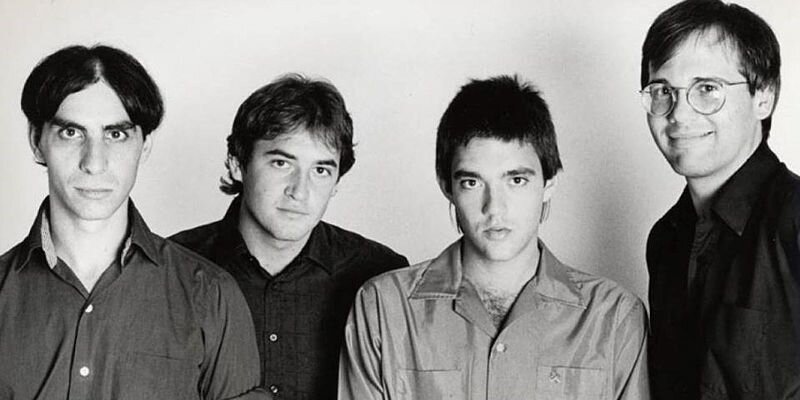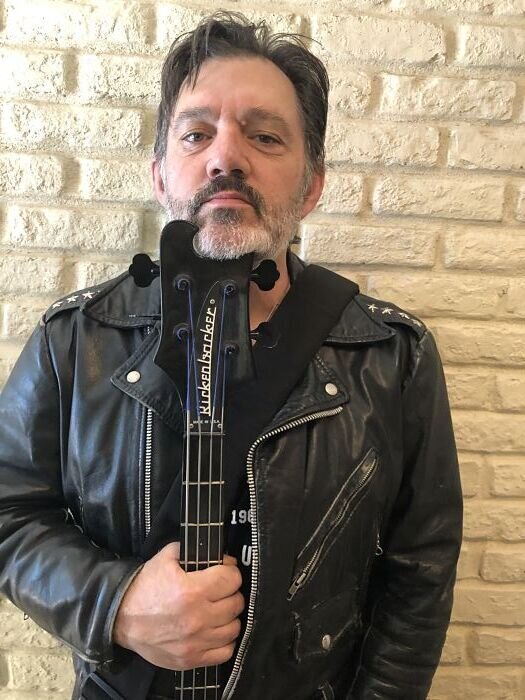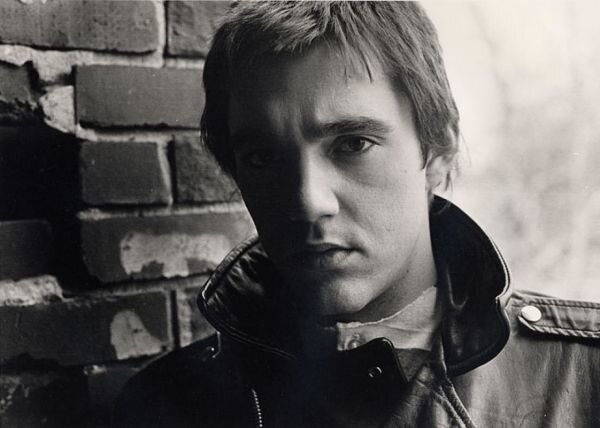Mike Mesaros (The Smithereens)


Photo by Gayle Miller
The furtive rumble of the bass beneath the power chords, vocal melodies, and a stealthy backbeat…
When the topic of rock and roll’s greatest rhythm sections arises, producers, engineers and assorted journos often cite Sir Macca / Richard Starkey MBE, Wyman / Watts, Ward / Butler, Benjamin / Jamerson, The Ox / Moon, Tallent / Weinberg, Bruce / Baker, McVie / Fleetwood, Taylor / Deacon, Blaine / Kaye, and Quaife / Avory – among the select few – as “elite.”
KYBP hereby renders an addendum to the aforementioned revered cadre of icons – as reported by Joe Gagliardo! Enter Messrs. Mesaros / Diken!


Photo by Kat Wolfe
By Joe Gagliardo
Talk about a bass player and drummer being locked in!
Mike Mesaros and Dennis Diken of The Smithereens have been friends since the third grade. They spent their formative years spinning records together long before they started playing music.
Jim Babjak, The Smithereens’ guitarist – wasn’t far behind. Friends since the fifth grade – the three musical pals joined with Pat DiNizio of in 1980, and thus emerged The Smithereens.
At seventeen, Mike picked up the bass. Jim had already been playing guitar for about five years, and drummer Dennis was a working musician by the 8th grade.
Mesaros’ decision was driven, in part, by his love of doo wop music, and the significance of the bass vocal—just check out “Blue Moon” by The Marcels. Recalling his first bass as “a $15 piece of junk,” Mesaros quickly upgraded to a mid-70s Rickenbacker 4001.
After Jim Babjak showed Mike a few notes and songs on his instrument, Mesaros was off and running. The budding bassist studied classic 50’s cuts including the work of Guybo Smith, who played on most of Eddie Cochran’s records.
When soaking up the sounds of that era, Mike paid particular attention to the left hand of the legendary piano players on records by Chuck Berry, Little Richard, Fats Domino and Jerry Lee Lewis – just listen to Jerry Lee’s during the piano break on “Great Balls of Fire” to understand where Mesaros is coming from!
This work ethic affected Mike’s development in multiple ways. He practiced hard so that he could rise to the occasion and play with musicians who were far more advanced than him at the time.
The ability of Mike to play an unrehearsed bass riff at the end of a song, and have Dennis do a supportive roll on the drums, or vice versa, is part of what makes Mike and Dennis such a formidable rhythm section.
Because the band plays songs which leave room to stretch out, they each respond instinctively to what the others are playing.
Renowned E Street Band bassist Gary W. Tallent described The Smithereens as a two guitar, bass and drums rock and roll band. He went on to say that they had obviously taken the time and effort to study the music that came before them, but they then took that music to a place that was true to its roots, but in a way that gave it a completely unique identity.
Tallent’s description of the band also applies to the development of Mike Mesaros’ bass playing. The Mesaros household resonated with the sounds of swing and big bands, country, and Frank Sinatra, Jerry Vale, Al Martino, and the other popular vocalists of the day.
Mike was also absorbing the AM radio music coming out of New York, which was eclectic— back then the Top 40 charts included Sinatra, Dean Martin, Louis Armstrong, alongside The Beatles, Stones, surf instrumentals, and the soulful sounds of Motown, Stax and Atlantic. Mike’s most significant musical influences came from the 45s and LPs Dennis Diken would spin for him over the many years they spent hanging out together.
In October 2019, the band had the esteemed honor of being inducted into the New Jersey Hall of Fame. The Smithereens joined legends, including Frank Sinatra, Tony Bennett, Sarah Vaughan, Count Basie, Bruce Springsteen and The E Street Band, Steven Van Zandt, Jon Bon Jovi, and Frankie Valli and The Four Seasons, among others.
Mike’s studying of bass players carried on with players of the 60’s and beyond: Paul McCartney, John Entwistle, Brian Wilson, Ronnie Lane (Small Faces/Faces), Jack Bruce, James Jamerson, Carl Radle (listen to his slide on one string in “After Midnight”, which makes a simple bass line sound interesting), and Joe Osborne. Osborne’s playing on “Midnight Confessions” (The Grass Roots) and San Francisco (Scott Mackenzie), are just a few examples Mike cited.
Although he rarely plays with a pick, Mike absorbed the aggressive pick playing of Dee Dee Ramone, Andy Shernoff (The Dictators) and JJ Burnel (The Stranglers), as well as the melodic playing of Graham Maby (Joe Jackson), Gary Tallent (E Street Band), Bruce Foxton (The Jam), Bruce Thomas (The Attractions) and Andrew Bodnar (Graham Parker And The Rumour).
Mike describes his playing style as “a musical soup of his influences,” but just as Gary Tallent described the band, Mike has taken those influences and created a unique sound. He has a broad musical vocabulary, and while he plays with power and energy, his goal is to have his bass lines be a song within the song.
He wants his bass lines to lock in with the drummer’s foot pedal so that it sounds like the bass drum is playing notes. Mike strives for accurate and consistent notes and tone, and understands that what you don’t play is as important as the notes you play. Mike practices daily, and he switches it up to keep it interesting. He is a proponent of using scales as a warmup. After that, he likes to play along with records–20s and 30s Jazz, Motown, or whatever is on his mind that day.
He also works on Smithereens’ songs to keep them fresh, and in his head. Mike is driven about growth; always wanting to be better tomorrow, than he is today. That drive has led him to studying legendary upright players, including Ray Brown and Oscar Pettiford. He feels that through those listening experiences, he has added an upright element to his playing on the electric bass, including the expanded use of walking bass lines, using half steps.
In terms of his gear, his go-to basses are three Fender Precision basses from the ’73-75 era, as well as two Rickenbacker Blackstar basses. The Precision basses have been modified with DiMarzio pickups and Badass bridges. He prefers dead flat wound strings, and believes you can’t beat the E string on a P bass. In contrast, the Rickenbackers are great for playing octaves and in the upper register, as well as for hammer-ons and string bending. The Smithereens records were recorded primarily with the Fender Precision basses.


Photo by Cindy Mesaros
Mike’s philosophy is that 80% of a bassist’s sound is driven by the bass itself, and his/her hands. He plays primarily with his fingers, and uses no pedals or effects, choosing to change the sound of the bass depending on how he uses his fretting hand to create vibrato to make the note ring out, or create a ghost note. While he anchors his right hand on the E string and his pinky on the bridge, he also changes his sound by moving his plucking hand closer to the pickup and neck. For his bass rig, he wants to just cleanly amplify the sound he is creating with his bass and hands. His go-to rig to get a punchy, clean and articulate sound is a Gallien Krueger 800RB, running through 2 4×10 Hartke cabinets with aluminum cones.
When it comes to constructing bass lines, Mike believes songs are like movies, and that the bass lines should all be different. He listens to the song to figure out whether it is subdued or ebullient, and to identify the places where he can accentuate the vocal or hook of the song. His goal is to have the bass line build and change as it moves through the verses, choruses and solos. Prior to entering the studio to record, Mike would take Pat DiNizio’s demo tapes, and using his 4-track tape machine, he would play along with the demo and record different bass lines. He could then pick out the lines that he thought would work best with each song and Dennis Diken’s drumming.
While there have been many memorable events for The Smithereens since their formation in 1980, Mike counts among his favorites: the band’s first tour, which was with The Ramones; its 1990 appearance on Saturday Night Live; and its 2019 induction into the New Jersey Hall of Fame.
A personal highlight for Mike goes back to the late 70s, when he and Dennis had a band called The Targets, and they were playing at Kenny’s Castaways on Bleecker Street. After a set, accomplished bassist Doug Lubahn (KYBP https://bit.ly/2ZWb5bZ ), who played on three Doors LPs, as well many other projects, called him over to the bar to compliment his playing.


Bassists Graham Maby and Mike Mesaros at the Stone Pony – Photo by Gayle Miller
You can catch Mike and The Smithereens live, and you can check out his playing here, on some of his favorite Smithereens songs.
Also check out his commentary about the songs:
“Blood And Roses” https://youtu.be/vqML7WbOun8
This song changed my life. Pat came up with the basic bass line, let me develop it, and he built the song around it. A great gift from Pat to me.
“Deep Black” https://youtu.be/j3PauBeJkNI
I improvised about 50% of the bass lines in the studio, thinking I would go back and redo them. To my surprise, I liked how I played, and left them unchanged. Definitely, a confidence booster.
“Strangers When We Meet” https://youtu.be/nfecRUgOGVc
This song has a Beach Boys feel, so I tried to fuse how I thought Brian Wilson would approach the song, with my idea of punch and energy.
“Everything Changes” https://youtu.be/ymetDT29iyQ
This has an ominous sound, reminiscent of The Stranglers, so I played with a pick, trying to capture the sound of JJ Burnel.


Photo by Kat Wolfe